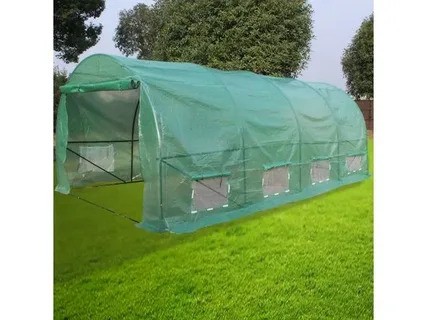
For growers, both commercial and hobbyist, the greenhouse is more than just a structure; it is a meticulously controlled environment designed to optimize plant growth, extend growing seasons, and protect crops from the unpredictable nature of the outdoors. The most critical component of this controlled environment is the cover itself. The right material can mean the difference between a thriving harvest and a crop lost to extreme weather or poor light conditions. In this critical decision-making process, two key factors stand out for their ability to enhance durability and performance: the resilience of Heavy Duty Greenhouse Covers and the unique light-diffusing properties of white greenhouse plastic. Understanding the specific advantages of each is essential for making an informed choice that will protect your investment and maximize your yield.
The Uncompromising Durability of Heavy Duty Greenhouse Covers
The primary purpose of a greenhouse cover is to create a secure, stable microclimate, and for this, durability is non-negotiable. Heavy Duty Greenhouse Covers are specifically engineered to withstand the harshest elements, offering a level of protection that standard films simply cannot match. Their “heavy-duty” classification typically refers to their thickness, which is measured in mils (a thousandth of an inch). While standard films may be 4 mil thick, heavy-duty options are generally 6 mil or thicker, which significantly increases their tear resistance, puncture strength, and overall longevity.
This enhanced durability is a crucial factor for growers in regions with challenging weather. A heavy-duty cover provides superior protection against strong winds, hail, and the wear and tear of a long, harsh winter. It reduces the risk of catastrophic failure during a storm, which could lead to an entire crop being exposed and damaged. Furthermore, these covers are often treated with advanced UV inhibitors. Ultraviolet radiation from the sun is one of the primary reasons greenhouse films degrade over time, becoming brittle, yellowing, and losing their integrity. By using a film with a high concentration of UV stabilizers, a heavy-duty cover can maintain its strength and clarity for multiple growing seasons, reducing the frequency and cost of replacement. This long-term resilience not only offers peace of mind but also proves to be a more cost-effective solution over the life of the greenhouse.
The Transformative Power of White Greenhouse Plastic
While durability is about protection, the choice of a film’s color and transparency is about performance and the quality of light. White greenhouse plastic, also known as diffuse film, represents a strategic choice for growers looking to optimize light and temperature within their structure. Unlike clear films, which allow sunlight to pass through directly, a white or milky-white film works by scattering the light as it enters the greenhouse. This diffusion effect has several profound benefits for plant health and growth.
The most significant advantage of white greenhouse plastic is its ability to eliminate shadows and ensure more uniform light distribution throughout the entire plant canopy. In a greenhouse with a clear cover, plants and their leaves will cast shadows on lower foliage, potentially limiting growth in those areas. The scattered light from a white film penetrates deeper and more evenly, ensuring that leaves at the bottom of the plant receive adequate light for photosynthesis. This can lead to a more consistent, robust, and higher-quality yield across the entire crop, as all plants receive a similar amount of light regardless of their position.
Furthermore, white greenhouse film plays a crucial role in temperature regulation. The diffusion of light helps to prevent the formation of “hot spots”—areas where direct, intense sunlight can cause the temperature to soar and potentially scorch delicate plants. By scattering the light, the film helps to distribute the heat more evenly, lowering the overall temperature inside the greenhouse. This is particularly beneficial for growers in hot climates or for those cultivating heat-sensitive crops. The cooler, more consistent environment created by white greenhouse plastic reduces plant stress, minimizes the need for excessive ventilation, and can lower energy costs associated with cooling systems. The benefits of both heavy-duty construction and a white color are not mutually exclusive; growers can often find a single product that combines the durability of a heavy-duty film with the light-diffusing properties of a white one, offering the best of both worlds.
Choosing the Right Cover for Your Growing Environment
The decision between various Heavy Duty Greenhouse Covers and the choice of a clear versus white greenhouse plastic ultimately depends on a grower’s specific needs, climate, and crops. In regions with frequent high winds, hail, or heavy snow loads, the investment in a heavy-duty, high-mil film is a wise and necessary safeguard. The peace of mind that comes with knowing your structure is well-protected is invaluable.
The choice of film color, on the other hand, is more about the nuances of your growing strategy. If you are in a hot, sunny climate and are growing heat-sensitive plants like lettuce, microgreens, or certain flowers, a white, diffuse film is an excellent choice to mitigate heat stress and prevent scorching. The even light distribution will also lead to better quality produce. Conversely, if you are growing plants that require maximum light intensity, such as specific vegetables or fruits in a cooler climate, a clear film might be a more suitable option to ensure every last bit of sunlight reaches the crops. However, even in these scenarios, a diffuse film can be beneficial by eliminating shadows and preventing burning. Many growers find that a diffuse film offers the most versatile and forgiving environment for a wide variety of plants.
Installation and Maintenance for Longevity
Regardless of the film chosen, proper installation and ongoing maintenance are key to maximizing its lifespan. Ensuring the film is stretched taut and securely fastened to the greenhouse frame is crucial for preventing flapping in the wind, which can lead to tears and premature wear. Using proper fasteners and avoiding sharp edges on the structure can also prevent damage. Regular cleaning of the film to remove dirt, dust, and algae will ensure maximum light transmission and maintain its intended properties. By pairing the right film for your needs with diligent care, you can ensure that your greenhouse remains a productive and protected environment for many growing seasons.
Conclusion:
The choice of a greenhouse cover is one of the most important decisions a grower will make, and the market offers solutions designed for every need. The superior strength and resilience of Heavy Duty Greenhouse Covers provide a necessary defense against the forces of nature, protecting valuable crops and offering a long-lasting, cost-effective solution. At the same time, the unique properties of white greenhouse plastic transform the quality of light within the structure, promoting more uniform growth, reducing plant stress, and managing internal temperatures more effectively. By strategically combining these two vital features—durability and light diffusion—growers can create a precisely tailored environment that not only withstands the elements but also actively works to ensure a bountiful and high-quality harvest, year after year.






